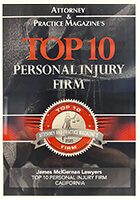How Long Does a Pedestrian Accident Settlement Take?

If you’re wondering how long does it take to settle a pedestrian accident, a big part of the answer lies in understanding the insurance company’s playbook. Insurance adjusters are trained professionals whose goal is to resolve claims for the lowest amount possible. They often use specific strategies, like making quick, lowball offers or intentionally delaying the process, hoping you’ll accept less out of frustration or financial pressure. This is why the timeline can be so unpredictable. An experienced attorney knows how to counter these tactics, keep the pressure on, and build a case that the insurance company has to take seriously. This guide will help you understand these dynamics so you can be prepared for the process.
Key Takeaways
- Your Recovery Dictates the Timeline: The single most important factor determining how long your settlement takes is your medical treatment. It’s essential to wait until you’ve reached Maximum Medical Improvement (MMI) to ensure your final compensation covers all long-term costs.
- Complexity and Insurance Tactics Will Cause Delays: A straightforward case can settle within a year, but disputes over fault, serious injuries, or an uncooperative insurance company can significantly extend the process. Expect insurers to use strategies like lowball offers to slow things down.
- Proactive Steps Protect Your Claim’s Value: You can prevent unnecessary hold-ups by seeking immediate medical care, documenting everything, and avoiding common mistakes like giving a recorded statement. Partnering with an experienced attorney is the most effective way to counter delays and secure fair compensation.
How Long Does a Pedestrian Accident Settlement Take?
After being injured in a pedestrian accident, it’s completely understandable to wonder how long it will take to resolve your case and get your life back on track. While there’s no magic number, the timeline for a settlement depends heavily on the specifics of your situation. Factors like the severity of your injuries, how clear the fault is, and the insurance company’s willingness to negotiate all play a significant role.
The most important thing to remember is that you shouldn’t rush the process. Your priority is to get the medical care you need to recover. A settlement can only be reached once the full extent of your injuries and related costs are known. Some cases resolve relatively quickly, while others require more time to ensure you receive the full and fair compensation you deserve for your medical bills, lost wages, and suffering. We can help you understand the path ahead and manage each step, so you can focus on healing.
Simple vs. Complex Cases
The complexity of your case is one of the biggest factors influencing your settlement timeline. A straightforward case—where liability is clear and your injuries are minor with a quick recovery—will generally settle faster. These types of claims often resolve within six to 12 months after you’ve completed all your medical treatment.
On the other hand, more complex cases naturally take longer. If you’ve suffered serious injuries requiring surgery or long-term care, or if there’s a dispute over who was at fault, the timeline will extend. These cases can often take between 12 and 16 months, or even longer, to settle after your medical treatment has concluded. This extra time is necessary to fully document your damages and build a strong case for fair compensation.
When Litigation is Necessary
Most pedestrian accident claims are settled through negotiations with the insurance company. However, if the insurer refuses to make a fair offer, the next step is often filing a lawsuit. This doesn’t automatically mean your case will go to a full trial—in fact, the vast majority of lawsuits still settle before reaching a courtroom.
Filing a lawsuit does, however, add time to the process. The insurance company alone can take one to three months just to review your medical records before making an initial offer. Once a lawsuit is filed, there are additional legal steps like discovery and depositions that can extend the timeline by several months or even years. While it takes longer, this step can be crucial for holding the at-fault party accountable and securing the compensation you need.
What Factors Affect Your Settlement Timeline?
If you’re wondering how long your pedestrian accident case will take, the honest answer is: it depends. No two cases are exactly alike, and several key factors can speed up or slow down the process. While it’s frustrating to wait, understanding these elements can give you a clearer picture of the road ahead. Your timeline is shaped by the specifics of your accident, the nature of your injuries, and how the insurance company responds. Let’s walk through the main factors that will influence your settlement timeline.
The Severity of Your Injuries
The more severe your injuries, the longer your case will likely take—and for good reason. It’s crucial not to settle until we have a complete understanding of your medical needs. We wait until your doctor confirms you’ve reached “Maximum Medical Improvement” (MMI), which is the point where your condition has stabilized. For serious injuries like traumatic brain injuries, reaching MMI can take many months or even more than a year. Rushing to settle before this point means you could be left paying for future medical care out of your own pocket. We want to ensure your settlement covers everything, from initial treatment to long-term needs.
Who Was At Fault
Another piece of the puzzle is determining who was at fault for the accident. If liability is clear—for example, a driver admits to running a red light—the process can move more quickly. However, if there’s a dispute over who is responsible, your legal team will need time to build a strong case. This involves gathering evidence like police reports, witness statements, and traffic camera footage to definitively prove that the other party was at fault. While this investigation adds time to your case, it’s an essential step to ensure you get the compensation you deserve.
The Insurance Company’s Approach
Unfortunately, the insurance company’s attitude can significantly impact your timeline. Their goal is to pay out as little as possible, and some will use delay tactics or make lowball offers hoping you’ll accept out of frustration. An experienced attorney knows how to counter these strategies and keep the pressure on. If the insurance company refuses to negotiate in good faith and offer a fair amount, we may need to file a lawsuit to protect your rights. While this extends the timeline, it often becomes the necessary path to securing the full compensation you are owed for your injuries, pain, and suffering.
The Strength of Your Evidence
A strong case is built on strong evidence. The insurance company won’t just take your word for it; they require proof. You need to show that the other party was negligent, that you were injured, and that the accident directly caused those injuries. This means compiling a comprehensive file of medical records, bills, photos of the scene, and expert testimony if needed. The more thorough and organized your evidence is from the start, the harder it is for the insurance company to dispute your claim. Gathering this crucial evidence is a key part of the process and directly influences how smoothly negotiations will go.
How Injuries and Medical Care Impact Your Timeline
The single biggest factor influencing your settlement timeline is the nature and severity of your injuries. It might seem counterintuitive, but rushing to a settlement is rarely in your best interest, especially when you’re still recovering. The goal is to fully understand the extent of your injuries and the total cost of your medical care—both past and future—before you even begin negotiations. If you settle before your treatment is complete, you risk accepting an amount that doesn’t cover your long-term needs. This is a common mistake people make when they feel pressured by mounting bills, but it can leave them without the resources they need for future care.
Your medical journey is the roadmap for your legal claim. Every doctor’s visit, physical therapy session, and medical bill helps build a clear picture of your damages. A more complex injury requires a longer recovery period, which naturally extends the timeline for your case. We need to wait until your medical situation has stabilized to ensure we can demand compensation that truly covers everything you’ve been through and everything you will need moving forward. This patience allows your legal team to gather all necessary evidence and build the strongest possible case on your behalf. Let’s look at how different levels of injury can affect your settlement timeline.
Minor Injuries with a Quick Recovery
If you were fortunate enough to sustain relatively minor injuries—like sprains, cuts, or bruises—your path to a settlement is often more direct. When your medical treatment is straightforward and you make a full recovery within a few months, we can gather your medical records and bills quickly. Once your treatment is complete, we have a clear and final number for your medical expenses. Cases with clear liability and less complicated injuries often settle within 6 to 12 months after you’ve finished all your medical care. The process is faster because the damages are easier to calculate and present to the insurance company.
Serious Injuries Needing Ongoing Care
When an accident results in serious injuries that require surgery, hospitalization, or extensive rehabilitation, the timeline for your settlement will be longer. These cases can take between 12 and 16 months to resolve after your medical treatment has concluded. The extended timeframe is necessary to account for the full scope of your recovery. We need to see the results of your surgery, track your progress in physical therapy, and understand if there will be any lingering issues. This careful documentation ensures that your settlement demand includes every single cost associated with your more complex medical journey, from hospital stays to specialist consultations.
Permanent Disabilities and Future Needs
For devastating injuries that result in permanent disabilities, such as a traumatic brain injury or spinal cord damage, the timeline is significantly longer. In these situations, the focus isn’t just on past medical bills, but on calculating the cost of a lifetime of care. It’s essential not to even consider settling until your doctors agree that your condition has stabilized. This can take many months, or even more than a year. We often work with life care planners and other experts to project the costs of future medical treatments, in-home assistance, and necessary modifications to your home or vehicle. Securing your future is the priority, and that takes time.
Reaching Maximum Medical Improvement (MMI)
One of the most important milestones in any personal injury case is reaching what’s known as Maximum Medical Improvement, or MMI. This is the point when your doctor determines that your condition is stable and you’ve recovered as much as you’re expected to. It’s absolutely critical to wait until you’ve reached MMI before settling your claim. If you accept an offer too soon, you can’t go back and ask for more money later, even if your injuries worsen or you discover you need another surgery. Waiting for MMI protects you and ensures the compensation you receive truly reflects the full, long-term impact of the accident on your health and life.
The Settlement Process: A Step-by-Step Guide
Navigating the aftermath of a pedestrian accident can feel overwhelming, but the settlement process follows a structured path. While every case is unique, understanding these key stages can help you know what to expect as your attorney works to secure the compensation you deserve. From the initial paperwork to the final negotiations, each step is designed to build a strong case on your behalf and hold the responsible party accountable. Here’s a look at how the process generally unfolds.
Filing the Initial Claim
The first formal step is to file a claim with the at-fault party’s insurance company. This is more than just filling out a form; it’s the official start of your legal journey. Your attorney will handle this for you, ensuring all the details of the accident are accurately presented and the paperwork is submitted correctly and on time. They will gather crucial evidence, such as the police report, witness statements, and photos from the scene, to build a solid foundation for your case. This initial filing puts the insurance company on notice that you are seeking compensation for your injuries and other losses, setting the stage for all future communications and negotiations.
Documenting Medical Treatment
Your health is the top priority. Seeking immediate medical attention after an accident is not only critical for your recovery but also for your claim. It’s essential to follow your doctor’s treatment plan, attend all appointments, and keep detailed records of everything. These medical records create an official timeline of your injuries and the care you’ve received. Be sure to save all related bills, receipts, and explanations of benefits. This documentation serves as vital evidence, directly linking your injuries to the accident and proving the financial costs you’ve incurred. Your lawyer will use these records to calculate the full extent of your medical damages.
Sending a Demand Letter and Negotiating
Once you have recovered as much as medically possible—a point known as Maximum Medical Improvement (MMI)—your attorney will have a clear picture of your total damages. At this stage, they will draft and send a formal demand letter to the insurance company. This comprehensive document outlines the facts of your case, establishes the other party’s liability, and details all your losses, including medical expenses, lost income, and pain and suffering. The letter concludes with a specific monetary amount you are demanding as a settlement. This typically kicks off a period of negotiation, where your lawyer will communicate back and forth with the insurance adjuster to reach a fair agreement.
Deciding Between a Final Settlement or a Lawsuit
The goal of negotiations is to reach a fair settlement without going to court. In many cases, this is exactly what happens. Your attorney will present any offers from the insurance company to you and provide their professional opinion on whether it’s a reasonable amount. If the insurer refuses to offer a fair settlement, the next step may be to file a lawsuit. It’s important to know that filing a lawsuit doesn’t automatically mean you’ll end up in a trial. The vast majority of personal injury lawsuits still settle before reaching a courtroom. This step simply increases the pressure on the insurance company and allows your attorney to continue fighting for the compensation you deserve through the formal legal process.
How Insurance Companies Can Delay Your Settlement
It’s important to remember that insurance companies are for-profit businesses. Their primary goal is to protect their bottom line, which often means paying out as little as possible on claims. While they have a legal duty to act in good faith, many adjusters use specific strategies to minimize, delay, or even deny valid claims. Understanding these tactics is the first step in protecting your rights and ensuring you aren’t taken advantage of during a vulnerable time. Knowing what to expect can help you and your attorney build a stronger case from the start.
The Initial Claim Review
During the initial review, the insurance adjuster will scrutinize every detail of your claim. This is their first opportunity to find reasons to slow down the process. They might request excessive documentation, question the necessity of your medical treatments, or simply take an unreasonable amount of time to respond to your communications. If they refuse to offer a fair amount early on, it can be a sign that they are digging in for a long fight. This tactic is designed to wear you down, hoping you’ll eventually accept a lower offer out of frustration or financial pressure.
Negotiation Tactics
One of the most common insurance company tactics is to make a very quick, low settlement offer. While it might seem like a relief to get money fast, this is often a strategy to pay you less than your case is worth. They make these offers before you’ve had a chance to fully understand the long-term costs of your injuries, including future medical care or lost earning capacity. By accepting, you waive your right to seek further compensation. An experienced attorney can help you evaluate any offer and determine if it truly covers all of your past, present, and future damages.
Common Delay Strategies to Watch For
Insurance companies will look for any misstep on your part to justify a delay. Simple timeline mistakes or missing information can give them an excuse to put your file on the back burner. They will also use any inconsistencies against you. For example, they might point to conflicting statements about the accident or even use your social media posts to argue that your injuries aren’t as severe as you claim. This is why it’s so critical to be careful about what you say and do after an accident. Trying to negotiate your own claim can also lead to significant delays, as adjusters may use your lack of legal knowledge to prolong the process.
Protect Your Claim: What to Do Right After an Accident
The moments after an accident can feel like a blur, but the steps you take are critical. Acting quickly and deliberately not only protects your health but also lays the groundwork for a strong personal injury claim. Here’s what you need to do to protect your rights from the very beginning.
Get Medical Attention Immediately
Your health always comes first. Even if you think your injuries are minor, get medical care right away. Some serious conditions, like internal bleeding or concussions, don’t show symptoms immediately. Seeking prompt medical attention creates an official record that directly links your injuries to the accident, which is essential for your claim. Be sure to follow your doctor’s advice precisely and keep a detailed file of all your medical records and bills. This documentation will become a cornerstone of your case when calculating the compensation you deserve.
Gather Evidence at the Scene
If you are physically able, gathering evidence at the scene can significantly strengthen your case. Use your phone to take photos of everything: the accident scene from multiple angles, the vehicle involved (including the license plate), any property damage, traffic signs, and your injuries. If there were any witnesses, ask for their names and contact information. Their accounts can be incredibly valuable. These steps help establish a clear picture of what happened and prove who was at fault, which can help move your case forward more efficiently.
File an Official Accident Report
Make sure the accident is officially reported by calling 911. When the police arrive, they will create an official accident report. This document is a neutral, third-party account of the incident and often contains key details, diagrams, witness statements, and the officer’s initial observations. An official report lends credibility to your claim and serves as a foundational piece of evidence. Once it’s available, you should obtain a copy for your records. In California, you are also required to report an accident to the DMV if there are injuries.
Speak with an Experienced Lawyer
Contact an experienced pedestrian accident lawyer as soon as possible. Insurance adjusters may try to contact you quickly to get a recorded statement or offer a low settlement before you understand the full extent of your injuries. A lawyer will protect your rights, handle all communications with the insurance company, and build a strong case on your behalf. They can help you understand your options and fight to ensure you receive fair compensation for your medical bills, lost wages, and suffering. Don’t try to handle this alone—let a professional guide you through the process.
Common Myths That Can Delay Your Settlement
When you’re recovering from a pedestrian accident, the last thing you need is more confusion. Unfortunately, there are many misconceptions about the personal injury settlement process that can cause unnecessary stress and lead you to make decisions that aren’t in your best interest. Believing these myths can create unrealistic expectations and potentially harm your claim. Let’s clear up some of the most common myths so you can approach your settlement with confidence and a clear understanding of the road ahead.
Myth: All Cases Settle Quickly
It’s natural to want a fast resolution, but it’s a myth that all pedestrian accident claims wrap up in a few weeks. The reality is that the time it takes to settle varies for every case. A straightforward claim with minor injuries and clear fault might settle relatively quickly. However, more complex cases often take much longer. If you have serious injuries, if there’s a dispute over who was at fault, or if the insurance company is being difficult, your case could take a year or more to resolve. Rushing the process can mean leaving money on the table, so patience is essential for securing fair compensation.
Myth: You Should Accept the First Offer
After an accident, you might receive a settlement offer from the insurance company very quickly. While it can be tempting to accept it and move on, this is often a strategy to get you to settle for less than you deserve. Insurance companies know you’re in a vulnerable position and may offer a low amount before you even know the full extent of your injuries and future medical needs. An initial offer rarely accounts for long-term care, lost earning capacity, or your total pain and suffering. It’s always wise to have an experienced attorney review any settlement offer before you even think about accepting it.
Myth: Every Case Goes to Court
The idea of a courtroom battle can be intimidating, but the truth is that most personal injury cases never see the inside of a courtroom. The vast majority of claims are settled out of court through negotiations between your attorney and the insurance company. Even if your lawyer finds it necessary to file a lawsuit to show the insurer you’re serious, the case will most likely still settle before it reaches a trial. Filing a lawsuit is a powerful step in the negotiation process, but it doesn’t automatically mean you’ll be facing a judge and jury. The primary goal is always to reach a fair settlement as efficiently as possible.
Myth: Negotiations Are a Fast Process
Once you send a demand letter, the back-and-forth of negotiations begins—and it’s rarely a speedy process. Insurance adjusters need time to conduct a thorough review of your claim, which includes analyzing all your medical records, bills, and other evidence. This review alone can take one to three months, and sometimes longer for cases with extensive injuries. After their review, they will respond with an initial offer, which is usually low. From there, your attorney will counter, and the negotiation process continues. Each step takes time, so it’s important to have realistic expectations and let your legal team handle the timeline.
Overcoming Common Insurance Negotiation Hurdles
Negotiating with an insurance company can feel like a strategic game where the rules aren’t always clear. Adjusters are trained to protect their company’s bottom line, which often means paying out as little as possible. Understanding their common tactics is the first step toward protecting your claim and ensuring you aren’t taken advantage of during a vulnerable time. Knowing what to expect can help you stand firm and focus on what truly matters: your recovery.
Dealing with Lowball Offers
It’s a classic move: shortly after your accident, the at-fault party’s insurance company presents a settlement offer. It might even seem like a decent amount of money at first glance. However, this initial offer is almost always a “lowball” offer—a figure that is far less than what your claim is actually worth. Insurance companies send these early to tempt you into settling before you understand the full extent of your injuries and future medical needs. They know you’re likely facing medical bills and lost income, and they use that pressure to their advantage. An experienced attorney can help you calculate the true value of your claim and reject offers that don’t fairly compensate you.
Disputing Fault or Liability
Another common hurdle is a dispute over who was at fault for the accident. Even if it seems obvious that the other party was negligent, their insurance company may try to argue that you were partially or even entirely to blame. This is a strategy to reduce or deny your claim. If there’s a disagreement about who caused the accident, your lawyer will need to invest time gathering and presenting strong evidence to prove the other person was at fault. This includes police reports, witness testimony, photos from the scene, and sometimes expert analysis. Successfully proving liability is the foundation of your entire case, so overcoming this hurdle is critical.
Responding to Pressure and Delay Tactics
Insurance companies often use time as a weapon. On one hand, they might pressure you to accept a quick settlement, as we discussed with lowball offers. On the other hand, they might drag the process out intentionally. These delays are designed to frustrate you and wear you down, hoping you’ll eventually give up and accept a lower settlement out of sheer exhaustion. They might be slow to return calls, request the same documents multiple times, or question the necessity of your medical treatments. Recognizing these delay tactics for what they are—a negotiation strategy—can help you stay patient while your attorney holds them accountable.
Handling Complex Medical Record Reviews
Before an insurance company makes a serious offer, they need to conduct a thorough review of all your medical records and bills. This step is necessary, but it can significantly extend your settlement timeline. The adjuster needs to see documentation for every doctor’s visit, physical therapy session, surgery, and prescription to understand the severity and cost of your injuries. For straightforward cases, this might take a month or two. However, for very complex injuries requiring long-term care, the medical review process can take much longer. While it can be frustrating, this detailed review is essential for justifying the compensation you deserve.
When Should You Consider Filing a Lawsuit?
Most pedestrian accident claims are settled directly with the at-fault party’s insurance company, without ever seeing the inside of a courtroom. But what happens when the insurance adjuster refuses to offer a fair settlement? That’s when filing a lawsuit becomes a powerful option.
Think of it as the next step in the negotiation process. Initiating a lawsuit doesn’t guarantee you’ll go to trial—in fact, the vast majority of personal injury lawsuits still settle before a verdict is reached. However, it signals to the insurance company that you are serious about getting the compensation you deserve. It moves your claim from an informal negotiation into the formal legal system, giving your attorney access to more tools to build the strongest possible case on your behalf. This formal process, known as litigation, allows your lawyer to subpoena documents, take sworn testimony from witnesses, and officially bring in expert opinions to validate the extent of your injuries and losses. Deciding to file a lawsuit is a significant step, and it’s a decision you and your lawyer will make together if settlement talks hit a wall.
Understanding the Statute of Limitations
One of the most critical factors in deciding when to file a lawsuit is the statute of limitations. This is a strict legal deadline for initiating a personal injury case. In California, you generally have two years from the date of the accident to file a lawsuit. If you miss this deadline, the court will almost certainly refuse to hear your case, and you will lose your right to recover any compensation permanently.
This is why it’s so important to speak with an attorney as soon as possible after your accident. Two years might seem like a long time, but building a strong case, gathering evidence, and negotiating with the insurance company takes time. An experienced lawyer will manage this deadline carefully, ensuring they preserve your right to file a claim in court if a fair settlement cannot be reached beforehand.
The Pros and Cons of Going to Court
Deciding to file a lawsuit involves weighing the potential benefits against the drawbacks. The biggest advantage is leverage. Filing a lawsuit often compels a stubborn insurance company to increase its settlement offer. It also opens the door to the “discovery” process, where your attorney can formally request evidence from the other side, take sworn testimony, and hire experts to strengthen your claim. This can uncover crucial information that makes your case even more compelling.
On the other hand, litigation is a much longer and more demanding process than pre-suit negotiations. It can be emotionally taxing and requires more of your time for things like depositions. While your attorney handles the legal heavy lifting, the process itself can add a layer of stress to your recovery. It’s a strategic decision that requires a clear understanding of what the process entails.
How a Lawsuit Changes Your Timeline
If you and your attorney decide to file a lawsuit, you should prepare for a longer timeline. While a straightforward claim might settle in a matter of months, a case that enters litigation can easily take a year or more to resolve. This is because the legal process has many built-in steps that take time to complete.
Once a lawsuit is filed, your case is subject to the court’s schedule. The timeline will now include phases for discovery (evidence gathering), depositions (sworn testimony), filing motions with the judge, and potentially mediation or a settlement conference. If the case doesn’t settle during these phases, it will be scheduled for trial, which could be many months or even years down the road. A settlement can still happen at any point, but the formal structure of the civil lawsuit process inherently extends the time it takes to reach a final resolution.
Secure Fair Compensation Without Unnecessary Delays
While you can’t control every aspect of your settlement timeline, you can take powerful steps to protect your claim and prevent avoidable delays. Focusing on what you can do now will help you build a strong case and put you in the best position to secure the compensation you deserve. It’s about being proactive and informed from the very beginning.
Partner with an Experienced Attorney
Navigating a pedestrian accident claim on your own can be overwhelming and often leads to delays. Partnering with an experienced personal injury attorney is one of the most effective ways to streamline the process. A skilled lawyer understands how to build a compelling case, gather the necessary evidence, and handle all communications with the insurance company. They know the tactics insurers use to stall and can counter them effectively. Having a professional advocate not only helps you pursue a better settlement but also allows you to focus on your recovery while they manage the complex legal details.
Know Your Rights
After an accident, it’s crucial to understand that you have the right to seek compensation for your losses. This isn’t just about covering your immediate medical bills. You can pursue payment for all related damages, including future medical treatment, lost wages from time off work, and the physical and emotional pain and suffering you’ve endured. An attorney’s job is to protect these rights. They will work to establish who was at fault, calculate the full value of your claim, and negotiate aggressively with insurance companies to ensure you aren’t shortchanged. Knowing what you’re entitled to is the first step toward getting a fair outcome.
Avoid Common Mistakes That Slow You Down
Simple missteps can unfortunately create major roadblocks in your settlement timeline. One of the biggest mistakes is speaking to the other party’s insurance adjuster without legal guidance. They may try to get you to make a recorded statement that can be used against you later. Other common errors include not getting immediate medical care, missing follow-up appointments, or posting details about your accident on social media. Even seemingly innocent photos or comments can be twisted to downplay your injuries. Being mindful of these pitfalls and providing your attorney with complete and accurate information will help keep your case on track.
Related Articles
- What to Do if You’re Hit by a Car as a Pedestrian
- Is It Too Late to Get a Lawyer for a Car Accident?
Frequently Asked Questions
Why can’t my lawyer give me an exact date for when my case will settle? It would be wonderful if we could circle a date on the calendar, but every case has its own unique rhythm. The timeline depends on factors we can’t predict at the start, like how long your recovery takes and how cooperative the insurance company decides to be. A responsible attorney will focus on securing the best possible outcome for you, which means taking the necessary time to build a strong case rather than rushing to a finish line that might not serve your best interests.
Should I accept the insurance company’s first settlement offer if I need money now? It’s completely understandable to feel pressured by mounting bills, but accepting the first offer is almost always a mistake. Insurance companies know you’re in a tough spot and often make a quick, low offer hoping you’ll take it before you know what your claim is truly worth. This initial amount rarely covers future medical needs or the full extent of your lost wages. It’s critical to discuss any offer with your attorney first to ensure you aren’t leaving money on the table that you will need for your long-term recovery.
Does filing a lawsuit mean my case will definitely go to trial? Not at all. This is a common worry, but the reality is that the vast majority of personal injury cases settle out of court. Filing a lawsuit is a strategic step we take when an insurance company refuses to negotiate fairly. It’s a powerful tool that shows them we are serious and often brings them back to the table with a much more reasonable offer. Think of it as the next phase of negotiation, not a guaranteed trip to the courtroom.
Why is it so important to wait until I’ve finished my medical treatment before settling? Waiting until your doctor says you’ve reached “Maximum Medical Improvement” is crucial for protecting your future. If you settle too early, you lose the right to ask for more money later, even if you discover you need another surgery or long-term physical therapy. By being patient, we can present a complete picture of all your medical costs—past, present, and future—to ensure the compensation you receive truly covers the full impact of the accident on your life.
What can I do to help my own case and avoid unnecessary delays? You play a key role in keeping your case moving forward. The best things you can do are to follow your doctor’s treatment plan without fail, keep detailed records of your expenses, and be completely open with your attorney about your recovery. It’s also wise to stay off social media, as insurance companies can twist your posts to argue against your claim. Clear communication with your legal team and a focus on your health are your most powerful contributions.


























